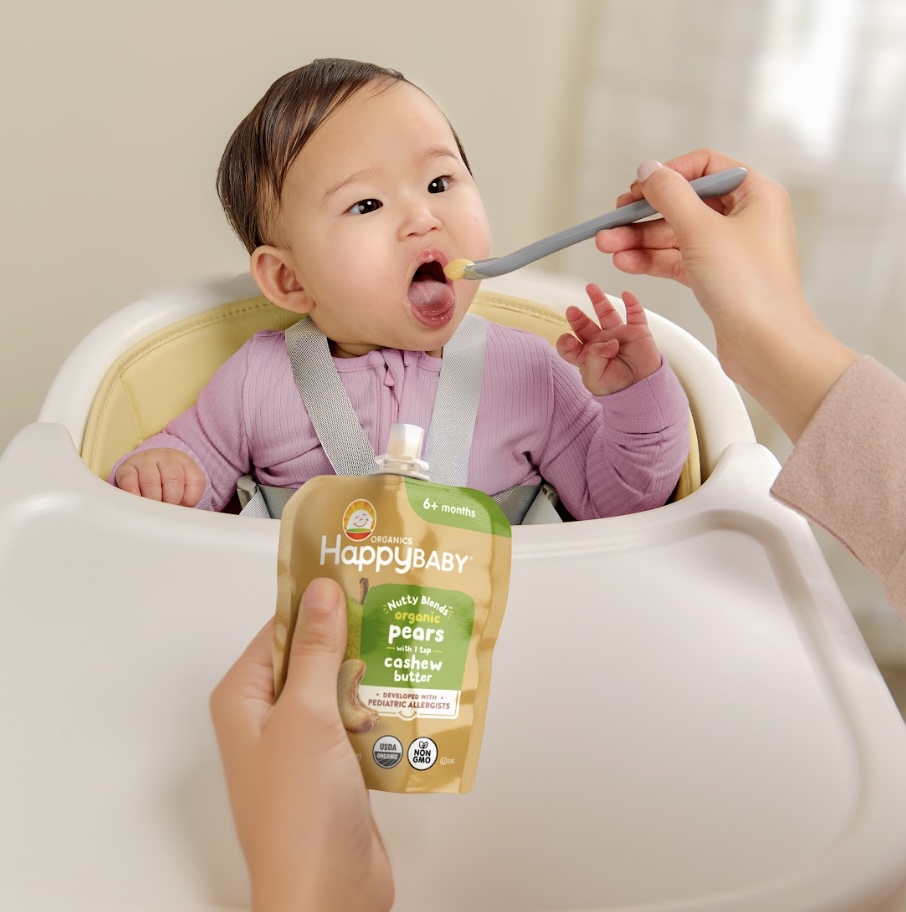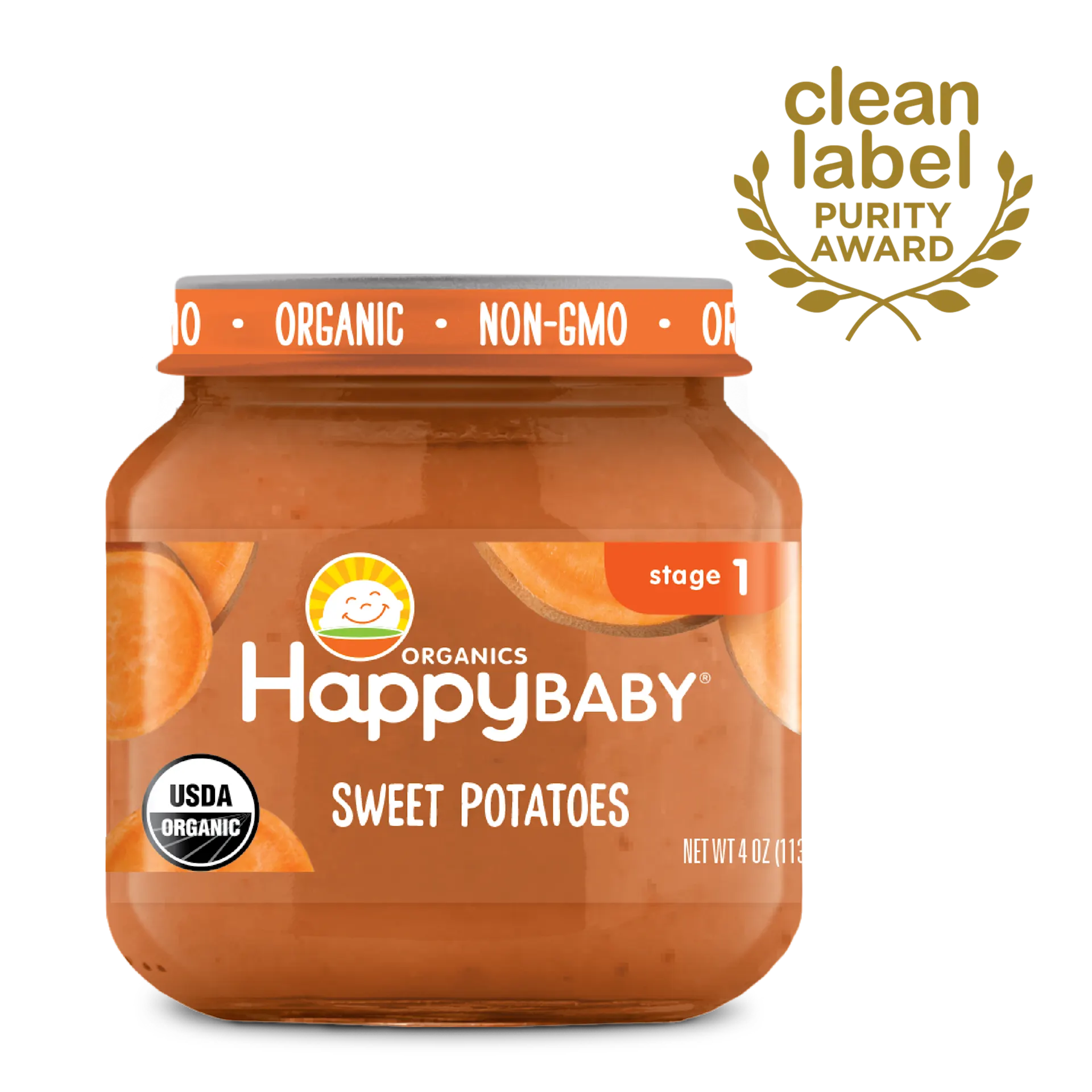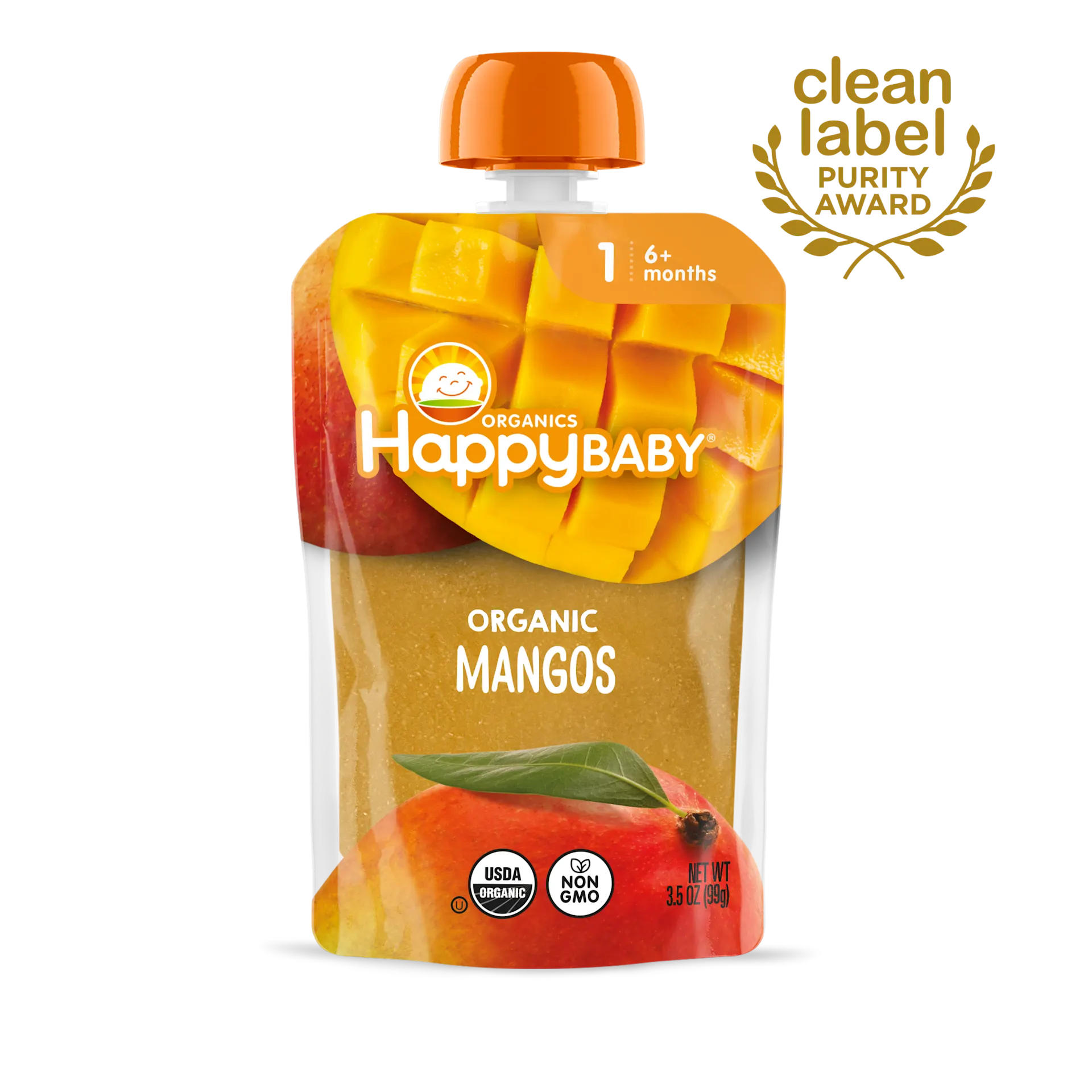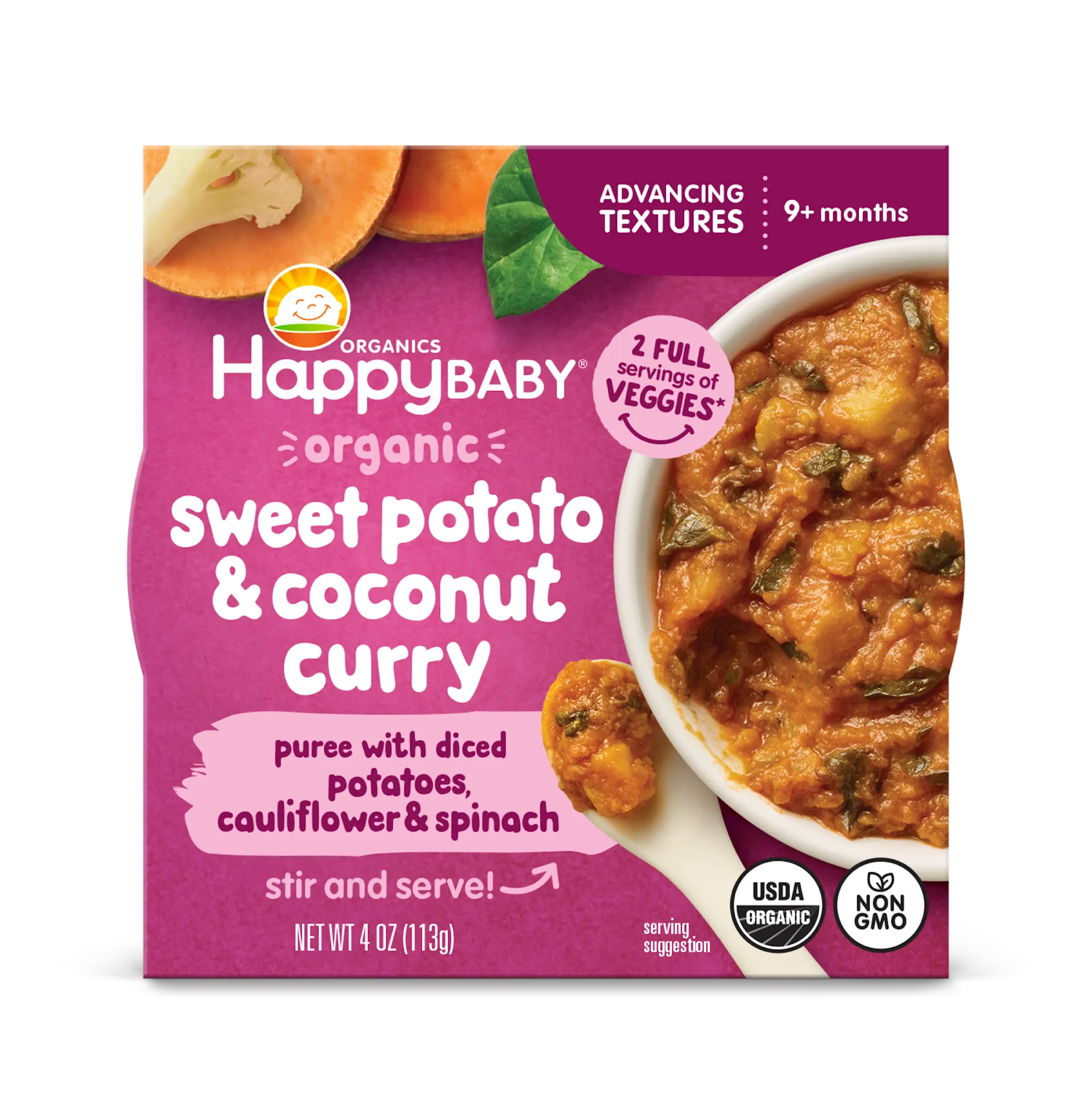In partnership with Happy Family. Editor’s Note: We only select and work with partners that meet our quality standards, so you can rest assured we only endorse products we believe in. All opinions are our own.
You’ve just gotten into a smooth rhythm with milk feeds when suddenly your baby turns six months old, and your pediatrician says it’s time to start solids. Introducing solids is an exciting (and messy!) milestone, and the start of sharing your favorite foods with your baby. But it can also feel overwhelming, especially if you’re a first-time parent. Which foods should you start with? How much should your baby eat? And what if they don’t seem interested?
I get it, I’ve been there. As a pediatric dietitian and mom of three, I’m sharing my top tips to help you confidently introduce solids, enjoy those silly food faces, and make sure your baby is getting the nutrition they need for growth and development.
What to Know Before You Begin
Before diving into mashed banana or avocado spears, it’s important to cover a few safety basics, starting with the question every parent has: When is my baby actually ready for solids?
According to the American Academy of Pediatrics (AAP), most babies are ready to begin solid foods around 6 months, as long as they’re also showing signs of developmental readiness. This means:
- Your baby can sit with little support.
- Your baby has good head control.
- Your baby can bring objects (like toys or utensils) to their mouth.
- Your baby is interested in watching you eat.
Once you notice these signs (which may appear just before or after 6 months), your pediatrician will likely give you the green light to start. Remember, solids are meant to complement breast milk or formula, not replace it. Your baby will still get most of their nutrition from milk feeds at this stage.
Embrace the Food Rainbow
When it comes to starting solids, variety is your best friend. Offering your baby foods from different food groups (like proteins, fruits, veggies, and grains) helps expose them to a rainbow of colors, textures, and flavors right from the start. This early variety provides a wide range of vitamins and minerals and also sets the stage for raising a curious eater and future foodie.
Here’s a peek at what a week of first foods might look like:
- Sunday: Cauliflower puree
- Monday: Avocado spears
- Tuesday: Organic Sweet Potatoes Baby Food Jar
- Wednesday: Plain Greek yogurt (whole milk)
- Thursday: Moist shredded chicken or mashed peas
- Friday: Iron-fortified oatmeal
- Saturday: Organic Mangos Baby Food Pouch
We like
We don't like
We like
We don't like
We like
We don't like
We like
We don't like
Happy Baby️ Organics
Organic Sweet Potato & Coconut Curry Puree with Diced Potatoes, Cauliflower & Spinach Baby Food
We like
We don't like
Educate Yourself on the Different Approaches to Starting Solids
There are different ways to start solids. There's no one “right” way, but understanding the different approaches can help you choose what feels best for you and your baby.
- Spoon-feeding: The traditional method of starting solids where a parent spoonfeeds a baby purees using a spoon.The parent controls portion size and feeding pace.
- Baby-led weaning (BLW): A new and more hands-on approach that allows babies to take the lead. Babies feed themselves soft, age-appropriate finger foods, like a banana spear, pancake strip, moist pieces of shredded chicken, or purees on a self-feeding utensil.
- Mixed approach: Combine spoon-feeding and BLW.
Once you’ve decided which approach feels right for you, consider taking a feeding course or reading up on the basics. A little preparation can help you feel confident when it’s time to start.
Introduce Allergens Early
One of the biggest reasons starting solids can feel stressful for parents is the fear of their baby having an allergic reaction. The good news is that many foods do not cause an allergic reactionand only about 8% of children in the United States are affected by food allergies.
In fact, introducing allergenic top foods early and frequently can significantly decrease the risk of your baby developing a food allergy. That’s why experts recommend introducing allergens to your baby once they start solids, and continuing to include them regularly in their diet.
The nine major allergens are: cow’s milk, wheat, egg, soy, sesame, tree nuts, peanuts, fish, and shellfish.
When introducing allergens, you can offer them on their own, like scrambled eggs (for BLW) or puree a hardboiled egg. You can also mix major allergens with foods less associated with allergic reactions, like stirring creamy, thinned-out peanut butter into applesauce, or for a quick and convenient option, you can offer a Happy Baby Organics Nutty Blend pouch, which is a blend of fruit and peanuts or treenuts.
Don’t Stick on Purees for Too Long
If you’ve chosen the spoon-feeding route, that’s great! Just make sure you’re gradually moving your baby along the texture train – from smooth purees to mashed and chunkier textures, and eventually to soft finger foods. It’s important for babies to experience a variety of textures early on and to introduce finger foods before 9 months, since waiting too long can make it harder for babies to accept new textures later.
And don’t worry, finger foods don’t need to be fancy or complicated. They can be as simple as:
- Avocado spears
- Happy Baby Organics Yogis
- Unsweetened whole grain muffin
- Roasted sweet potato spears
- Omelette strip
- Happy Baby️ Advancing Texture Bowls
- Greek yogurt with mashed berries
- Happy Baby Organic Teethers

Focus on Iron-Rich Foods
Around 6 months of age, your baby’s iron needs jump to 11 milligrams per day. To help meet those needs, it’s important to start including iron-rich foods in your baby’s diet. Iron supports your baby’s brain development, red blood cell production, and overall healthy growth. Examples of iron rich foods include:
- Beef
- Chicken
- Fish
- Iron-fortified infant cereal
- Lentils
- Beans
- Edamame
- Tofu
- Nuts
Invest in Quality Feeding Gear
You don’t need a ton of fancy gadgets to start solids, but having the right essentials can help. Start with a sturdy highchair that supports your baby’s posture with a footrest. Proper positioning provides your baby with the stability they need to eat safely and comfortably, and reduces squirming, wiggling, or flailing during meals.
Next, stock up on a few self-feeding spoons and silicone suction bowls or plates that stick to the tray (because yes, babies love to throw things!). These tools encourage independence and make it easier for your baby to explore food without as much frustration. Finally, save yourself some cleanup time by placing a splat mat under the highchair or a disposable tablecloth to catch all those inevitable spills and crumbs.
Give Yourself a Break
Making baby food from scratch is wonderful (go you!) because you get to control the ingredients and you know exactly what’s in every bite. But you’re also human, and a parent, which means convenience is an important part of the equation. I like to do a mix of mostly homemade meals with a few store-bought staples for busy days, travel, or those times when you just can't.
One brand I love for quick, on-the-go options is Happy Family Organics. Their fruit and veggie pouches are perfect for park or beach days and the Yogis and Teethers are great for independent eaters who want nothing to do with a spoon. Plus, it’s a brand I can trust. Each product is formulated by a team of pediatricians, food experts, and real parents to help kids reach key developmental and nutritional milestones.
Enjoy the Process!
This is the most important tip of all because babies pick up on your energy. If mealtime feels stressful or rushed, they’re likely to sense it and may become fussy or hesitant to try new foods. On the other hand, if you stay relaxed, smile, and make it playful, your baby will be more willing to explore and enjoy eating.
Eating is meant to be joyful and fun. Mealtime is about creating positive experiences that help your baby build healthy habits and develop a healthy relationship with food. Embrace the (many!) messes, the funny faces, and don’t forget to have your camera ready.


















.jpg)




